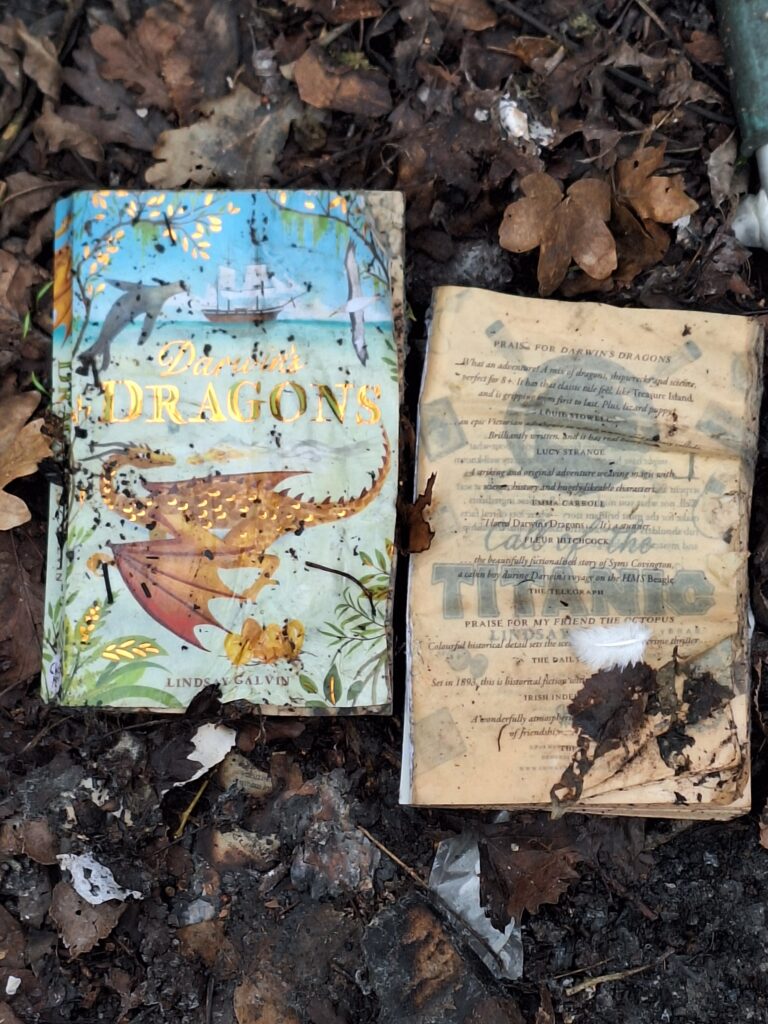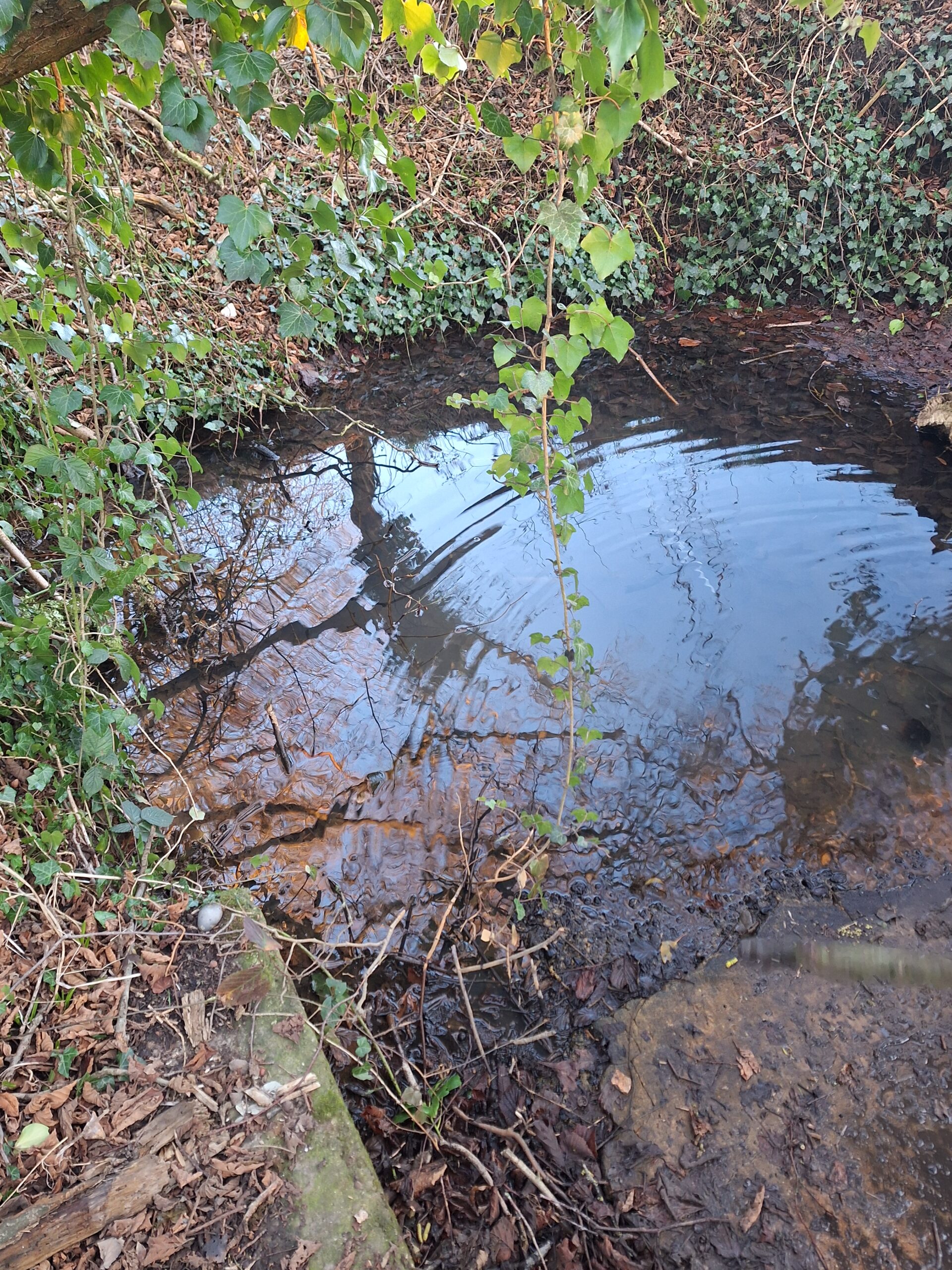
In the same place I had pulled the sword out of the fire – (a metal pole out of the remnants of a fire in the woods) I found a book that had been torn in half. The first side up identified the book as Darwin’s Dragon by Lindsey Galvin. The second half of the book showed pages with a large print of the word Titanic. This felt important and was very early days of the quest. This is a series of 3 books by this author and is followed by the books My Friend the Octopus and The Call of the Titanic which confirmed the Titanic link. The book in the woods was found on the 22nd of January 2025.
Later, in the quest Richard Clements did a history search on St Mary’s Church in Runwell and found a grave in graveyard to a Mr. Edwy Ryerson a survivor of the Titanic Disaster. When we visited St Mary’s Church in Runwell on the 29th of June the name William was important which brought Mr. Ryerson and the Titanic thread back into the forefront
Born William Edwy Ryerson (1878) in Ontario Canada, when he was still quite young, he joined the Royal Canadian Dragoons and later a British Regiment and fought in the Boer War. He got married in 1906 to Florence and had six children. In April 1912 he signed up for the White Star Line Company and was assigned to the RMS Titanic (Royal Mail Ship) and set sail on the 10th of April. On the 14th of April, William was a lucky chap and was assigned lifeboat duty, lifeboat 9 to be precise and on the fateful night the lifeboat was launched with 56 passengers (the full capacity of the boat was 65) which is how he survived the disaster. He was picked up by the Carpathian and returned to England on 29th April. In the first world war William joined the 159th Gun Brigade, Royal Field Artillery and rose to the rank of Sergeant. After the war he had other jobs and travelled between Canada and the UK eventually retiring in Runwell Essex where he died on 9th Dec 1949. He grave was unmarked until a commemorative stone 100 years later was laid and is now a visual reminder of a man that survived one of most impactful disasters of the 19th century.
The series of books focuses on the journey of the HMS Beagle during the journey that Charles Darwin was aboard when he was exploring and researching for his book The Evolution of Man however at the time we didn’t follow this link at all, we were too focused on other threads.
Jumping forward in time and if you recall I wrote an Article; https://spirit-and-soul-island-crystals.square.site/s/stories/a-little-bee-synchronicity which talks about the number of Bees that were under the Blackberry bush at Rettendon and the synchronicity of what I read that very night.
Now within this is had come to our attention that there were at least 3 custom cutter ships that bore the name ‘Bee’ and we had followed other threads which had led us to Maldon, but that is another story for another time.
On the 3rd of July we decided to visit St Andrews Church in Rochford, we had no reason to visit except the Tudor period kept raising its head in particular the Bolyn family so it seemed remiss to miss going and having a look. The house itself was linked to Mary Bolyn whom lived there when she was disgraced for marrying beneath her station to Sir William Carey, now it is a golf course and clubhouse, the church itself is in the grounds of the golf course. Whilst we were there a fellow quester got the impression of an explorer and happened to mention Darwin’s boat the HMS Beagle that had apparently been moored at Paglesham. The HMS Beagle had three major epic exploration voyages but was retired and refitted as a static watch vessel for the Essex Coastguard to curb smugglers.
Basically, the ship was situated in a mud dock, which basically means that the ship is moored in one place, and the keel sits on the mud at low tide. These kinds of ships are not sailing ships so need to be supported by a shored-up mud dock. These ships were lived on, and the Beagle housed 11 coastguards and their families according to a 19th century census. In 1870 the Beagle was sold for scrap, and the materials were repurposed elsewhere. These days all that remains is remnants of the mud dock which was discovered by Wessex Archeology in 2019. They believe that there may well be some remains of the beagle buried in the mud as this would have been difficult to remove, however this has yet to be discovered. The site is now classed as a scheduled monument as mud docks are a rare find even though they were common back in the day, currently only 5 mud docks have been found in the UK.
This brought a whole new level of meaning to the book found in the wood;
Darwin’s Dragon/Titanic
Both parts of the book have led us to an extraordinary man buried at Runwell St Mary’s and now we have a Ship buried beneath the mud which both link to areas in the quest. This is a massive Coincidence, and this is the nature of a psychic quest. How this all ties together we don’t know, all we can do is follow the threads that spirit bring to us and see where is leads us too. All I can say is that this journey is immense fun and I know spirit are enjoying it as much as we all are, we are visiting beautiful places and finding out so much hidden in plain sight information about the county we live in that we wouldn’t have discovered before and that is in itself is a treasure.
